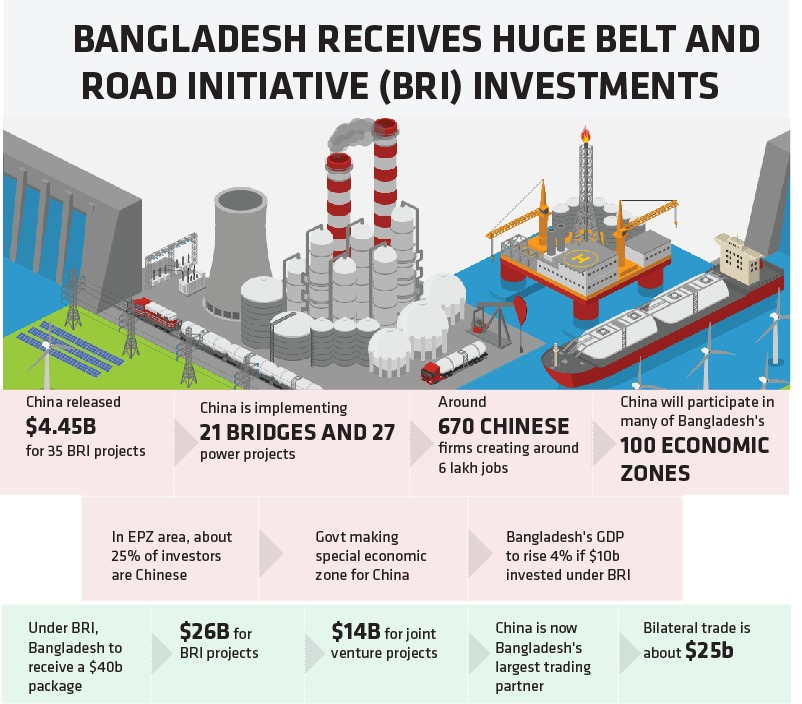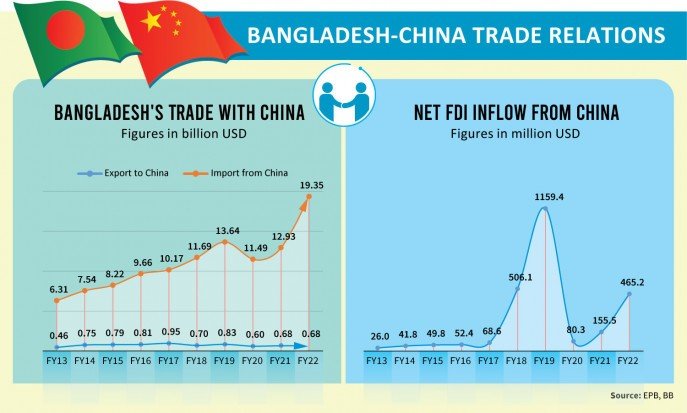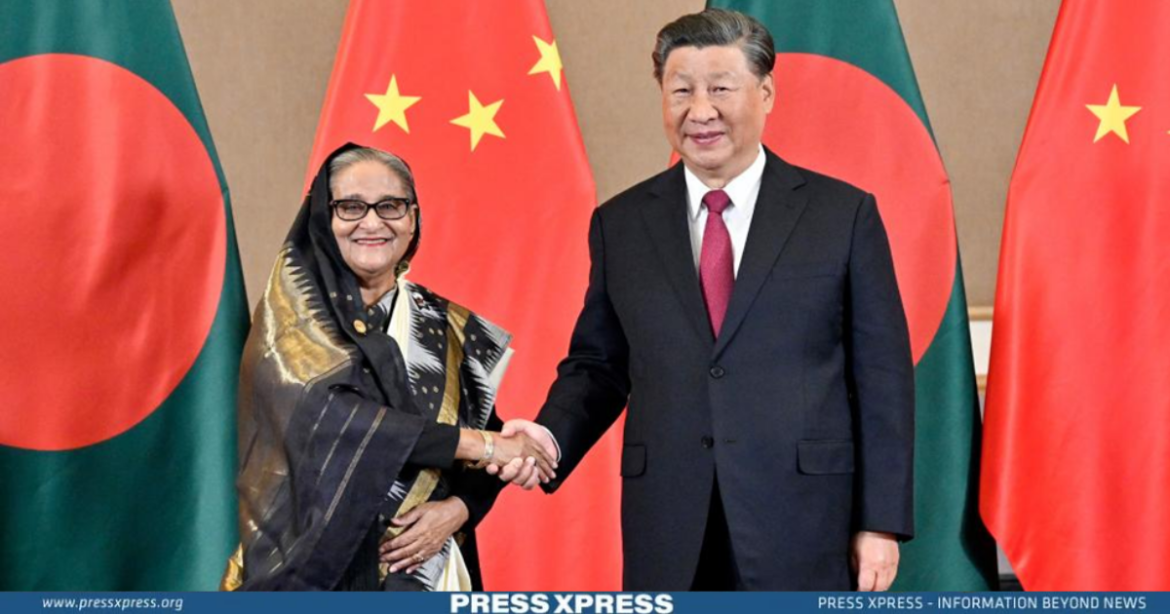The ongoing positive tale of Bangladesh’s economic growth provokes us to see China’s massive participatory engagement in multiple sectors at a time when both countries are holding hands together strongly to draw mutual benefits.
Why does a big economic country like China tabled policy to expand its economic collaboration across the world, of which Bangladesh is a part? In simple words, it is to gain national development and expand global influence on the account of geo-strategy.
China’s spectacular export performance is a prominent feature of the country’s economic post-1980s reform process that saw China’s share of global merchandise exports increase from 1.8 percent in 1990 to 3.9 percent in 2000, to 11.2 percent in 2012. Some observers forecasted that by 2030, China will account for 15 percent of global merchandise exports.
You can also read: Chinese Research Ship Stirs Security Concerns in Indian Ocean
The presence of Chinese economic policy of collaboration is vividly visible everywhere in Bangladesh’s development landscape. From road-rail to seaport and airport, under-river tunnel to elevated expressway, water utility to e-governance, coal power to solar power –the people of Bangladesh will feel it. Apart from being a major importing partner, the Asian economic powerhouse came forward with cash, technology, and expertise to boost much-needed development in Bangladesh.
According to a 2023 estimate by the American Enterprise Institute (AEI), a US think tank, the total investment from China in Bangladesh is $7.07 billion. In addition, Chinese companies have received construction contracts worth $22.94 billion in different sectors.
In the last 10 years, China has released $4.45 billion for 35 projects under the Belt and Road Initiative (BRI), Chinese Ambassador to Bangladesh Yao Wen said at a program recently in Dhaka.
BRI Boosting Bangladesh’s Infrastructural Development

The bilateral partnership between China and Bangladesh has been longstanding, but it has intensified since 2017 when Bangladesh became part of the Belt and Road Initiative (BRI). This is a global development strategy launched by Chinese President Xi Jinping in 2013, also known as the New Silk Road that aims to connect East Asia and Europe through land and maritime routes. Bangladesh is connected to one of the six economic corridors envisioned in this plan.
The energy and transport sectors, which require 1.5% of GDP in infrastructural investment by 2040, are the main areas of BRI projects in Bangladesh. To realize Vision 2041 and boost its economy, Bangladesh needs to address the infrastructure deficits where China’s BRI plays a larger role.
According to a report by the Asian Development Bank, Bangladesh needs to invest $608 billion in infrastructure. China’s BRI helping Bangladesh meet this demand by providing funds, technology, and expertise for various projects, such as the Padma Bridge, the Bangabandhu Tunnel, and the Dasherkandi Sewage Treatment Plant.
“The 12 highway and 21 bridge projects represented by the Padma Multipurpose Bridge are the extension of the present-day ‘Silk Road’ in Bangladesh,” Yao Wen, ambassador of China to Bangladesh, said at a program in Dhaka marking the 7th anniversary of Bangladesh’s participation in the Belt and Road Initiative.
The ambassador listed 27 power energy projects undertaken by Chinese enterprises, multiple municipal projects such as sewage treatment plants, and manufacturing and agricultural factories as “lighthouses” leading the steady and long-term cooperation between China and Bangladesh.
Bangladesh has received investment from about 670 Chinese firms. China will also join many of the 100 economic zones in Bangladesh. Besides the government, the private sector of Bangladesh has borrowed money from China. Data from the Bangladesh Bank shows that the amount of Chinese loans in the private sector is a little more than $2.33 billion. Most of the loans are for the power and energy sector.
Some of the other important road and bridge projects are Paksey Bridge, 8th Bangladesh-China Friendship Bridge, the Dhaka Bypass, Dhaka-Khulna (N8) Project, Dhaka Elevated Expressway, and Dhaka-Ashulia Elevated Highway Project. Among the seven railway lines under construction with a total length of 541.9 kilometers, Padma Bridge Rail Link Project, Tongi to Bhairab double-track line, Dohazari to Cox’s Bazar Railway are some of the notable ones.
China’s Contribution to Bangladesh’s 100 Percent Electricity Coverage
Bangladesh has achieved a remarkable feat by ensuring 100 percent electricity coverage for its people. This milestone was reached with the inauguration of the first China-funded eco-friendly mega power plant at Payra in Patuakhali district on March 22, 2022. The 1320 MW coal-fired power plant, built by China National Machinery Import and Export Corporation (CMC) and North-West Power Generation Company Limited (NWPGCL), is a flagship project under the BRI. This power plant uses ultra-supercritical technology to reduce emissions and save coal consumption and is expected to generate about 10 billion kWh of electricity annually, meeting the demand of about 12 million households and more than 10,000 jobs for the local people to boost the socio-economic development of the region.
China’s support for Bangladesh’s energy transition is crucial, as the country has pledged to produce 40 percent of its electricity from renewables by 2041. To meet this target, Bangladesh needs to invest $80 to 100 billion between 2030 and 2050 and is looking abroad for finance, with China being a key partner.
China A Major Trade Partner

China is now Bangladesh’s largest trading partner. The trade volume between the two countries is about $25 billion. Bangladesh mainly imports capital machinery and raw materials from China.
On the other hand, Bangladesh exports vegetables, frozen and live fish, leather and leather products, textile fibers, paper yarn and woven fabrics, garments, and apparel items to the country.
Bangladesh imported goods worth more than $17.45 billion during the fiscal year while exported commodities worth $0.61 billion.
China remains the number-one import destination for supplies to Bangladesh for a long, replacing neighboring India. Imports from there account for around 22 percent of total import volume.
Starting from 1 July 2020, China granted duty-free access to 97% of Bangladeshi products. This was later raised to 98%. Bangladesh resumed exporting crabs and eels to China last July. These two products bring in about $50 million annually from China for Bangladesh.
Risky Business?
China has become a major trading partner for Bangladesh and an important player in the infrastructural development of the country, said Sahab Enam Khan, a professor of international relations at Jahangirnagar University.
He said the benefits of growing bilateral trade and Chinese investment in infrastructure will have a positive spillover effect on the trade relations and connectivity projects between Bangladesh and India.
The success of Chinese investment in infrastructure will largely depend on the financial viability of the projects and their direct correlation with export returns. Investment in capital markets and Special Economic Zones (SEZs) will also have the potential to bring long-term benefits, he added.
Although Bangladesh’s economy is quite robust, with GDP growth increasing amid global economic volatility, the large amounts of loans pouring into Bangladesh could increase the risk of indebtedness in the long term.
However, experts said that Bangladesh will not fall into a debt trap as the government utilized most of the investment in profitable sectors like rail, and bridge which will further accelerate economic growth and generate revenue.


